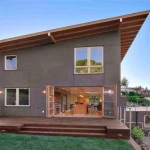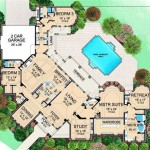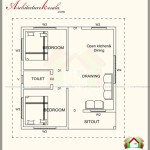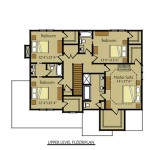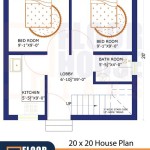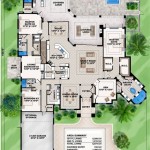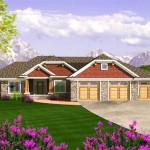Small Two-Story House Plans for Narrow Lots: Maximizing Space and Style
The demand for housing in urban areas and densely populated regions continues to grow, often presenting challenges due to limited land availability. Narrow lots, characterized by their restricted width, pose a unique set of design considerations for homeowners and architects. Small two-story house plans offer a practical and efficient solution for these constraints, providing ample living space while minimizing the building's footprint. This article examines key aspects of designing and implementing small two-story house plans on narrow lots, focusing on architectural styles, spatial optimization, and relevant building codes.
Optimizing Vertical Space and Layout Efficiency
The primary benefit of adopting a two-story design on a narrow lot is the ability to maximize vertical space. Instead of sprawling horizontally, living areas are stacked, allowing for a more compact ground floor footprint. This approach frees up valuable yard space, which can be utilized for landscaping, outdoor living areas, or parking, particularly important on narrow lots where lateral space is limited. The layout within a small two-story home must be carefully considered to avoid feeling cramped or restrictive. Open-concept designs for the ground floor, combining living, dining, and kitchen areas, are common strategies to create a sense of spaciousness. Strategic placement of windows and skylights can also enhance natural light penetration, further contributing to a brighter and more open feel.
Staircase design is a crucial element in a two-story home, especially on a narrow lot. Space-saving staircase options, such as spiral or alternating tread stairs, can minimize the square footage occupied by the staircase while still providing safe and convenient access to the upper floor. Careful planning of the staircase location can also improve the flow of traffic within the home and prevent the staircase from becoming a visual obstruction. Additionally, incorporating storage solutions under the stairs is a practical way to maximize available space and declutter living areas.
On the second floor, bedrooms and bathrooms are typically located. Careful consideration should be given to the size and layout of these rooms. Built-in storage solutions, such as wardrobes and shelving, can optimize space utilization and minimize the need for bulky furniture. Bathroom layouts should be designed to maximize functionality within a small footprint, utilizing space-saving fixtures and clever storage strategies. Furthermore, incorporating a small home office or study area on the second floor can cater to the growing trend of remote work, further enhancing the practicality of the design.
Effective zoning within the two-story layout is essential for creating a comfortable and functional living environment. Separating public and private areas, such as placing bedrooms on the upper floor and living areas on the ground floor, provides privacy and minimizes noise disruption. Careful consideration should also be given to the placement of utilities, such as HVAC systems and plumbing, to ensure efficient operation and minimize noise pollution. Soundproofing measures, such as insulated walls and floors, can further enhance the overall comfort and privacy of the home.
Architectural Styles and Exterior Design Considerations
Numerous architectural styles can be adapted to suit a small two-story house on a narrow lot. The choice of style should consider both aesthetic preferences and the specific constraints of the lot. Contemporary designs, with their clean lines, minimalist details, and emphasis on natural light, are often well-suited for narrow lots. These designs typically feature large windows, simple rooflines, and a focus on maximizing interior space. Traditional styles, such as Victorian or Craftsman, can also be adapted, but may require more careful planning to ensure that the architectural details do not overwhelm the limited space.
The exterior design of a small two-story house on a narrow lot should aim to create visual interest and enhance curb appeal without compromising functionality. Incorporating vertical elements, such as dormers or gables, can add visual height and prevent the house from appearing too squat. The choice of exterior materials, such as siding, brick, or stone, can also significantly impact the overall aesthetic. Lighter colors can make the house appear larger and more open, while darker colors can add a sense of sophistication and drama. Landscaping plays a vital role in enhancing the curb appeal of a small house. Utilizing vertical gardening, such as climbing vines or trellises, can maximize green space without encroaching on the limited yard area.
Window placement is a critical aspect of exterior design. Large windows can maximize natural light penetration and create a connection to the outdoors, but they should be strategically placed to ensure privacy and minimize heat gain. Utilizing energy-efficient windows can also reduce energy consumption and lower utility bills. Consider the orientation of the house and the prevailing wind patterns when designing the window placement, ensuring adequate ventilation and minimizing exposure to harsh weather conditions. Overhangs or awnings can provide shade and protect windows from direct sunlight, further improving energy efficiency.
The roof design can also significantly impact the overall aesthetic and functionality of a small two-story house. Simple rooflines, such as gable or hip roofs, are often the most practical and cost-effective options. Flat roofs can also be utilized, but they require careful attention to drainage and waterproofing. Green roofs, which incorporate vegetation, can provide insulation, reduce stormwater runoff, and enhance the aesthetic appeal of the house. The choice of roofing materials, such as shingles, tiles, or metal, should consider both durability and aesthetic appeal. Lighter-colored roofing materials can reflect sunlight and reduce heat gain, while darker-colored materials can absorb heat and improve energy efficiency in colder climates.
Navigating Building Codes and Regulations
Designing and building a small two-story house on a narrow lot requires careful adherence to local building codes and regulations. These codes typically address aspects such as setbacks, lot coverage, height restrictions, and fire safety. Setbacks, which are the minimum distances required between the building and the property lines, are particularly important on narrow lots, as they can significantly impact the available building area. It is crucial to consult with local zoning officials and obtain the necessary permits before commencing construction.
Lot coverage restrictions, which limit the percentage of the lot that can be covered by buildings and impervious surfaces, are another important consideration. Minimizing the building's footprint and utilizing permeable paving materials can help comply with these regulations. Height restrictions, which limit the maximum height of the building, can also impact the design of a two-story house. It is essential to carefully measure the building's height and ensure that it complies with local zoning ordinances. Fire safety regulations typically address aspects such as fire-resistant construction materials, fire separation distances, and the provision of fire extinguishers and smoke detectors.
Accessibility requirements, such as those mandated by the Americans with Disabilities Act (ADA), may also need to be considered, particularly if the house is intended for elderly or disabled occupants. Incorporating features such as ramps, wider doorways, and accessible bathrooms can enhance the usability and accessibility of the house. Energy efficiency regulations, which aim to reduce energy consumption and promote sustainable building practices, are becoming increasingly stringent. Utilizing energy-efficient materials, appliances, and HVAC systems can help comply with these regulations and lower utility bills.
In some jurisdictions, specific regulations may apply to narrow lot developments, such as requirements for shared driveways, party walls, or alley access. It is essential to research and understand these regulations before commencing the design process. Consulting with a qualified architect or builder who is familiar with local building codes and regulations can help ensure that the project complies with all applicable requirements and avoids costly delays or complications.

Narrow Lot Two Y House Plan With 4 Bedrooms Cool Concepts Plans Architectural

Modern Narrow House Plan View Park Beach Plans Designs

Beautiful House Plans For Narrow Lots Pinoy Designs Two Story Design 2 Y

Cool House Plans Offers A Unique Variety Of Professionally Designed Home With Floor By Narrow Lot Mini

Narrow Lot Two Y House Plan With 4 Bedrooms Cool Concepts

2 Story House Plans For Narrow Lots Blog Builderhouseplans Com

Beautiful House Plans For Narrow Lots Pinoy Designs Two Story Design Photos

2 Story House Plans For Narrow Lots Blog Builderhouseplans Com

Plan Pm 80806 2 3 Two Story Bed Modern House For Narrow Lot

Narrow Lot House Plans Home For Lots The Designers

